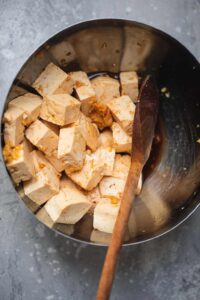Until the 1960s, the only type of soy sauce available in this country was the mass-produced, commercial variety. In the mid-1960s, George Ohsawa, father of the macrobiotic diet, introduced the natural, Japanese product to North America. This is what is commonly found in natural foods stores, inaccurately labeled tamari. What we buy as tamari (or in some instances labeled shoyu-tamari) is actually what is known in Japan as shoyu. Tamari in Japan is a by-product of miso and is a thicker, stronger tasting sauce. True tamari is rare in this country, so when you buy a product labeled tamari, chances are very good that you are really buying shoyu, or natural soy sauce.
Natural soy sauce is made from a combination of soybeans, roasted hard red wheat, sea salt, and water in more or less equal proportions. The mixture is ideally allowed to ferment in cedar vats for at least 18 months. When fully aged, the mixture is pressed to extract the liquid. Results vary according to specific recipes and regional preferences in Japan and China. The color of soy sauce ranges from light amber to black, and the flavor from pungent and salty to a more mellow salty-sweet. The quality and precise proportions of ingredients, the length of time aged, and the vats used in fermentation all contribute to differences in the flavor, color, and aroma of the sauce.
Mass-produced commercial soy sauces are made both in North America and in the Orient. The processes used to manufacture these are markedly different from the traditional ones used to create natural soy sauce, the most important of which are the following:
Mass-produced soy sauces are made from chemically produced defatted soybean pulp. This process strips soybeans of much flavor and some nutrition.
By using temperature controls, the fermentation process is artificially speeded up to be accomplished in no more than 3 to 4 months, which some argue, does not allow as fine a flavor to develop.
Chemicals and coloring agents are sometimes used to enhance the product. Because the shoyu is a product of naturally occurring biochemical processes, the compositions of the natural and mass-produced products are very different.
The Japanese-style natural soy sauce (shoyu) that is sold in natural-food stores has a more full-bodied flavor and tastes less salty than commercial soy sauce. Also available are a reduced-sodium natural soy sauce, which is allowed to ferment for 3 years to develop additional flavor (and again, by means of a much different process than mass-produced low-salt soy sauce), and a wheat-free natural soy sauce for those with wheat intolerance. Stored at room temperature, soy sauce will keep indefinitely.
Natural soy sauce has been shown to contain enzymes that aid in digestion and promote the production of beneficial bacterial cultures in the intestinal tract. The amino acids found in natural soy sauce complement those found in grains.
- For lots more features on healthy lifestyle, explore VegKitchen’s Healthy Vegan Kitchen page.
- Here are more of VegKitchen’s Natural Food Guides.






Comments
No Comments